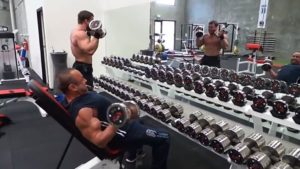
I recently posted an article about the 20-rep breathing squat– an oldie but a goodie from the golden era of bodybuilding. What happened next just confirmed what I have been seeing in the gym and in my courses: trainees complained via emails that it was almost impossible to get to 20 repetitions. I’m sure for the most fast-twitch of the guys, that is true, but for most people it’s due to poor conditioning. Low work capacity has been creeping up on people as video games and social media took over playing outside and having fun with friends, playing sports.
This sort of natural conditioning, and the manual labor that was a lot more present in everyday life just 20 years ago, is a missing component of fitness. Think I’m exaggerating? When is the last time you got up to change the channel on your TV? Right!
Of course, it takes more than that to achieve a good level of conditioning, but the point remains that everyday life has done its best to transform modern humans into the sort of hovering hippos from the movie Wall-E. And I heard they’re looking into flying chairs now….

Do you know how Arnold Schwarzenegger built not only his work capacity but also the starting capital for his empire? As a brick-layer. He and Franco Colombu were laying brick and building walls, chimneys and fireplaces before stepping into the gym at the end of the day. Hockey legend Maurice Richard from the Canadian Habs is another great example as he was working as a mechanic during his heyday on the ice. Another hard-worker in the bodybuilding world was Sergio Oliva, who worked in the meat-packing industry, often doing double-shifts before hitting the gym
Granted, the demands of pro sports have changed, but do you know of many professional athletes who have a day job? This translated later into the concept of GPP, or general physical preparation, where an athlete would build up their work capacity by doing high volumes of non-specific exercises. This compensated for a lack of general foundation as well as build up their work capacity to go through the necessary training needed to achieve their best on the field.
Starting with a good level of conditioning as a solid base of work capacity in the gym will certainly do a world of good to most trainees who complained they haven’t gained 20 pounds of solid muscle since last week while training their eleven inch arms hard on the Xbox. Plenty of tools can be used for this. I’m personally partial to strongman implements, as they build useable strength and energy systems capacity, especially when done in medleys. But I understand that most gyms do not carry the necessary equipment, or have the room for sleds and prowlers. No worries, you can do great things with dumbbells and barbells.
The Original Circuit
The use of barbells and dumbbells for conditioning was brilliantly demonstrated by Chicago-born bodybuilder Bob Gajda in 1966, where he defeated Sergio Oliva to win the Mr. America title. Bob used a method of conditioning called the “Peripheral Heart Action” or PHA for short.
PHA was the brain-child of Dr. Arthur Steinhaus, who invented it during the 1940s. Basically, it meant alternating upper body and lower body exercises to, as was understood at the time, make the heart work more by sending the blood to different muscle groups.
One of the characteristics of this system was the avoidance of localised pump. The goal was to send the blood to different areas of the body, circulating from muscle to muscle, and prevent muscle failure. More often than not, the weight was ramped up from set to set but that is not a prerequisite. A PHA workout usually consist of 4 to 6 sets of 5 to 8 exercises done for typically 10-12 reps with no rest other than the time to move from station to station or adjust the load. Of course, circuits can be scaled up or down depending on level of fitness. A sample workout can look like this:
– Front Squat
– Military Press
– Wide-Grip Pull-Ups
– Good Mornings
– Barbell Curl
– Hanging Leg Raise
This led of course to more traditional circuit training, where localised pump could be introduced and heavier loads were the norm. Many circuit-type methodologies have stemmed from this system, but they all emphasize short rests, moving from one exercise to the other in circuit fashion and working different muscle groups. But Peripheral Heart Action is the grand-daddy of them all.
The Giant Slayer
Another great gym conditioning method can be used, this one for specific muscle groups: giant sets. Anyone who has done them can tell you that the heart is working like a jackhammer long before the set ends. One who has pushed this concept to the limit is my good friend Milos Sarcev, who regularly put athletes in the top 10 of major bodybuilding competition such the Mr. Olympia. He achieves unreal level of conditioning by having his students do no cardio at all, and pushing them through his grueling giant sets, who often consist of 3 sets of giants sets made up of 10 to 15 exercisesfor the same muscle group. The workload can indeed make one very conditioned, and dramatic increase in work capacity are just one of the side effects of Milos’ methodology
Although very efficient, this example is an extreme. Less gruelling giant sets can be designed as well, usually consisting of 4 to 8 exercises that will increase muscle hypertrophy as well as work capacity. The inclusion of machines and cables makes this a typical bodybuilding system, but unless you own the gym or come when no one is around, it’s best to stick to barbells and dumbbells or use multiple different stances/grips/positions/variations on the same station.
The law of Repeated Effort
It’s no secret that high volumes of work can also increase work capacity. This is the case with German Volume Training. 10 sets of 10 reps of 2 antagonist exercises done with a 20RM load will have that effect. But the principle is not new. Vince Gironda used his infamous 8 x 8 method to condition some of best pupils, such as Mohamed Makkawy.Vince called the 8 x 8 the high-intensity “honest-workout” and it was one of his favorite rep scheme. He would select 3 to 4 exercises for a given muscle group and have his trainee do 8 sets of 8 reps with only 15 to 30 seconds of rest in-between sets. Talk about an honest workout when your spleen is coming out your left eye!
This is another great way to do high volume of work with little rest in order to build a better conditioning, and it needs little material. Just dumbbells and barbells
One method that became popular in the early 2000s was barbell complexes, where you would stack different exercises done with a barbell as a circuit, and do them with the same load. No changing the weight on the bar.
This method actually came about in the 70s-80s with Istvan Javorek, a strength and conditioning specialist from the Eastern Block who emigrated to America. It is convenient because it takes only 1 piece of equipment and little space, so this can be used in a commercial gym where Average Joes and Janes are training. Istvan would have his students do either the same number of reps on all exercises, or use different rep ranges depending of the exercises or the muscle group being worked. The principle was the same as a traditional circuit though: go from one exercise to another in a smooth fashion, with no rest between the transitions. Particular attention should be paid to the exercise sequence so they all flow naturally in a logical sequence. An example would be putting military press before front squat, whereas a dumb trainer would program back squat right before bent over rows.
This concept was heavily copied by internet gurus and online coaches who never gave Javorek proper credit for it, but it is an interesting method when properly done (i.e. something you rarely see online, where transitions don’t make much sense)
While the options to increase conditioning and work capacity abound, plain dumbbells and barbells offer a wide variety of possibilities. Increased work capacity translate to more work done in the gym when you go back to regular lifting, and help you get in even better shape.
So get under that bar!
Strength Sensei CP
